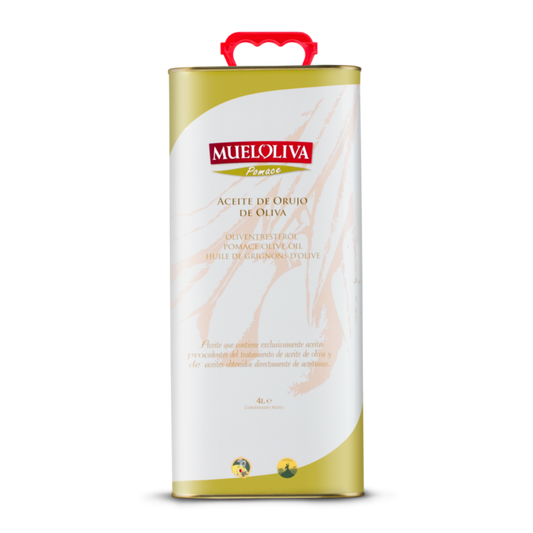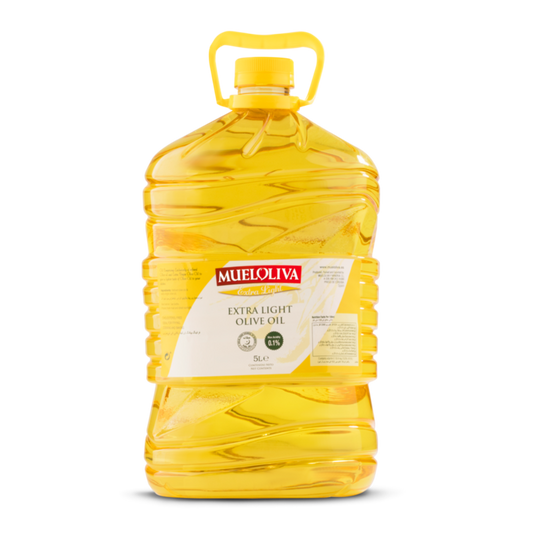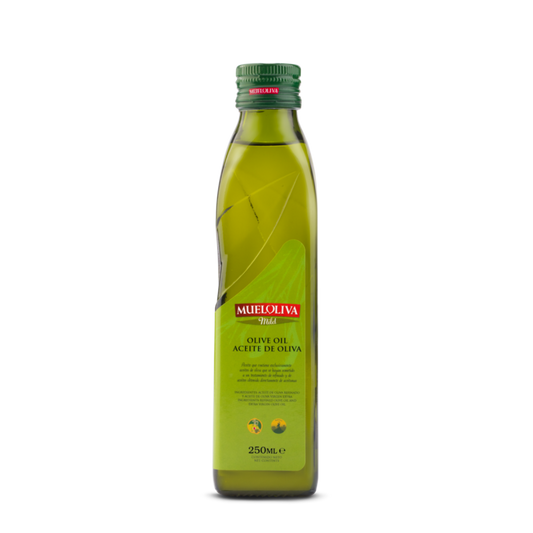-
Pomace Blended With Extra Virgin Olive Oil
Vendor:Mueloliva Olive Oil -
Extra Light Olive Oil
Vendor:Mueloliva Olive Oil -
Mild Olive Oil
Vendor:Mueloliva Olive Oil
FAQs
Olive Oil Common Questions
Can I use olive oil for cooking?
Yes, olive oil is fantastic for cooking. It's a versatile oil that can enhance the flavor of your meals while offering a variety of health benefits. Just remember, each type of olive oil has its ideal uses.
At our shop, we recommend you use Mueloliva Extra Virgin Picuda and Classica for medium-heat cooking, while Extra Light and Pomace olive oils are well-suited for high-heat cooking like deep frying and baking.
Can I fry or bake with olive oil?
Yes, you can use olive oil for frying and baking, but it's important to be aware of its smoke point. The smoke point is the temperature at which the oil starts to break down and produce smoke. When oil reaches its smoke point, it can produce unwanted flavors and potentially harmful compounds.
An olive oil’s smoke point depends on the type of olive oil. At Mueloliva, we produce many different types of olive oil:
- Mueloliva Extra virgin olive oil (EVOO) Picuda and Classica: Both these olive oils have a smoke point of 200°C. This makes them suitable for sautéing and light frying, but they are not the best choice for deep frying or baking due to their lower smoke point.
- Mueloliva Extra Light olive oil: which is refined, has a higher smoke point of approximately 240°C. This makes it a perfect option for high-heat cooking methods like frying and baking.
- Mueloliva Pomace olive oil has a similar smoke point to Mueloliva Extra Light at 240°C making it suitable for all types of frying and baking.
What is olive oil acidity and why is it important?
Acidity in olive oil refers to the amount of free oleic acid present in the oil. It is a key indicator of the quality and freshness of the olive oil.
Free fatty acids in olive oil are formed when the olives begin to decompose. This can happen if the olives are not processed soon after being picked, or if they are damaged, for instance by pests or rough handling.
Here's why the acidity level is important:
- Taste and Smell: High acidity can give the oil an unpleasant taste and smell. Lower acidity levels are associated with a fresher, fruitier flavor.
- Nutrition: Olive oil with lower acidity levels often contains more of the healthy compounds, like polyphenols and tocopherols, that make olive oil such a beneficial part of the diet.
- Shelf Life: Higher levels of free fatty acids can lead to faster oxidation of the oil, shortening its shelf life.
- Quality Indication: Acidity level is one of the key indicators for classifying different types of olive oil. According to the International Olive Council (IOC), to be classified as extra virgin (the highest quality of olive oil), the oil must have an acidity level of less than 0.8%. Virgin olive oil can have acidity up to 2%, and lampante oil (not fit for consumption until it's refined) has over 2%.
So, in essence, the lower the acidity of the olive oil, the higher the quality of the oil tends to be.
Do all olive oils taste the same?
No, not all olive oils taste the same. The taste of olive oil can vary greatly depending on several factors:
- Type of Olives: Different types of olive trees produce olives with different flavors, leading to varying tastes in the oils.
- Climate and Soil: The environment in which the olives are grown can significantly impact the taste of the oil.
- Harvest Time: The maturity of the olives at the time of harvest can also influence the flavor. Early-harvest olives tend to yield a more bitter, pungent oil, while later-harvest olives produce a milder, sweeter, and buttery oil.
- Production Process: The method and immediacy of processing after the olives are harvested can affect taste. Cold-pressed olive oils, for example, retain more of the original olive flavor. Also, oils made from freshly picked olives will often taste fresher than those made from olives that have been stored for a while.
- Storage and Age: Olive oil is a perishable product and can become rancid over time, especially when exposed to heat, light, or air. Fresh oil typically tastes better than older oil.
- Type of Olive Oil: Finally, the classification of the olive oil can affect its taste. Extra Virgin olive oil, which is made from pure, cold-pressed olives, tends to have a stronger flavor than refined types like Extra Light and Pomace olive oil.
So, it's clear that the flavor of olive oil can range from mild and buttery to bold and grassy, with notes of fruitiness, bitterness, or pepperiness.
Mueloliva Common Questions
What is the difference between Mueloliva Picuda and Classica Extra Virgin olive oils?
While both Mueloliva Picuda and Classica are 100% Extra Virgin olive oils, there are some big differences between the two:
- Acidity: The Picuda Extra Virgin olive oil has an acidity of 0.2%, which is the lowest level of any Extra Virgin olive oil in Pakistan. Classica has an acidity of 0.4%.
- Olive Source: Classica is made from Hojiblanca and Picual olives. Picuda is made from Picudo olives.
- Taste and Aroma: Picuda olive oil has a more intense taste and aroma. Classica has a much lighter taste and aroma.
How is your olive oil produced?
Here is our step-by-step process to make Mueloliva Olive Oil:
- Picking: In Andalusia, Spain, Mueloliva's seasoned experts handpick the best Picudo, Hojiblanca, and Picual olives each harvest season. The olives are quickly transported to our facility to keep them fresh.
- Cold-Pressing: The olives get a good wash, then they're pressed to extract the oil, always under a cool 27 degrees. The oil is separated from the pulp in our no-heat, no-chemical process.
- Analyzing: Next, we test the oil. If the acidity is less than 0.4%, it's considered Extra Virgin and gets packed as Extra Virgin Classica or Picuda.
- Refining: For oil with acidity over 0.4%, we refine it to reduce acidity, then blend it with Extra Virgin Classica. The result? Our Extra Light and Mild Olive Oils.
- Pomace Oil: Remember the Leftover pulp from pressing? We use solvents to extract any remaining oil from this pulp, refine and filter it. Finally, we blend it with Classica Extra Virgin to make Mueloliva Pomace olive oil.
- Export: All our olive oil variants — Extra Virgin, Extra Light, and Pomace olive oil — are ready to be shipped off to over 70 countries worldwide, including Pakistan.
That's how we do it at Mueloliva — from olive tree to your table, with love and care every step of the way!
How long do your products last?
Our olive oils have an expiry date printed on the bottle. Up until bottling, our olive oil is stored in stainless steel tanks that preserve the quality of the oil. Once opened, were recommend using up your oil within 1 to 2 months.
All Mueloliva Olive Oils are bottled in dark protective coloured, tightly sealed bottles to prevent exposure to light and heat.
Is your olive oil chemically analyzed?
Each and every batch of Mueloliva olive oil is chemically analyzed to check for acidity and nutrient quantity.
You can view our quality analysis certificates here: https://oliveoil.com.pk/pages/chemical-analysis-certificate
What other certifications do you have?
Storing Olive Oil
How do I keep olive oil fresh?
Two things that can damage olive oil are heat and light exposure.
To keep your olive oil fresh, store your oil away from heat and light. Additionally, aim to finish your olive oil within 1 to 2 months of opening the bottle.
All Mueloliva Olive Oils are bottled in dark protective colored, tightly sealed bottles to prevent exposure to light and heat.
What if my olive oil looks cloudy, murky or even solid?
Olive oil can appear cloudy, murky, or even solidify if it's stored in a cold environment, usually below 10°C. This will not impact the taste of the oil. This naturally occurs in fresh, high quality olive oil.
This is a natural process caused by the olive oil's fatty acids solidifying at different temperatures, and it doesn't affect the quality of the oil. If you find that your olive oil has solidified, simply leave it at room temperature and it will return to its liquid state.
What happens to olive oil when stored in high temperature?
Storing olive oil in a high-temperature environment can negatively affect its quality and shelf life. High temperature causes oxidation, nutrient loss and negative changes in the texture of olive oil.




